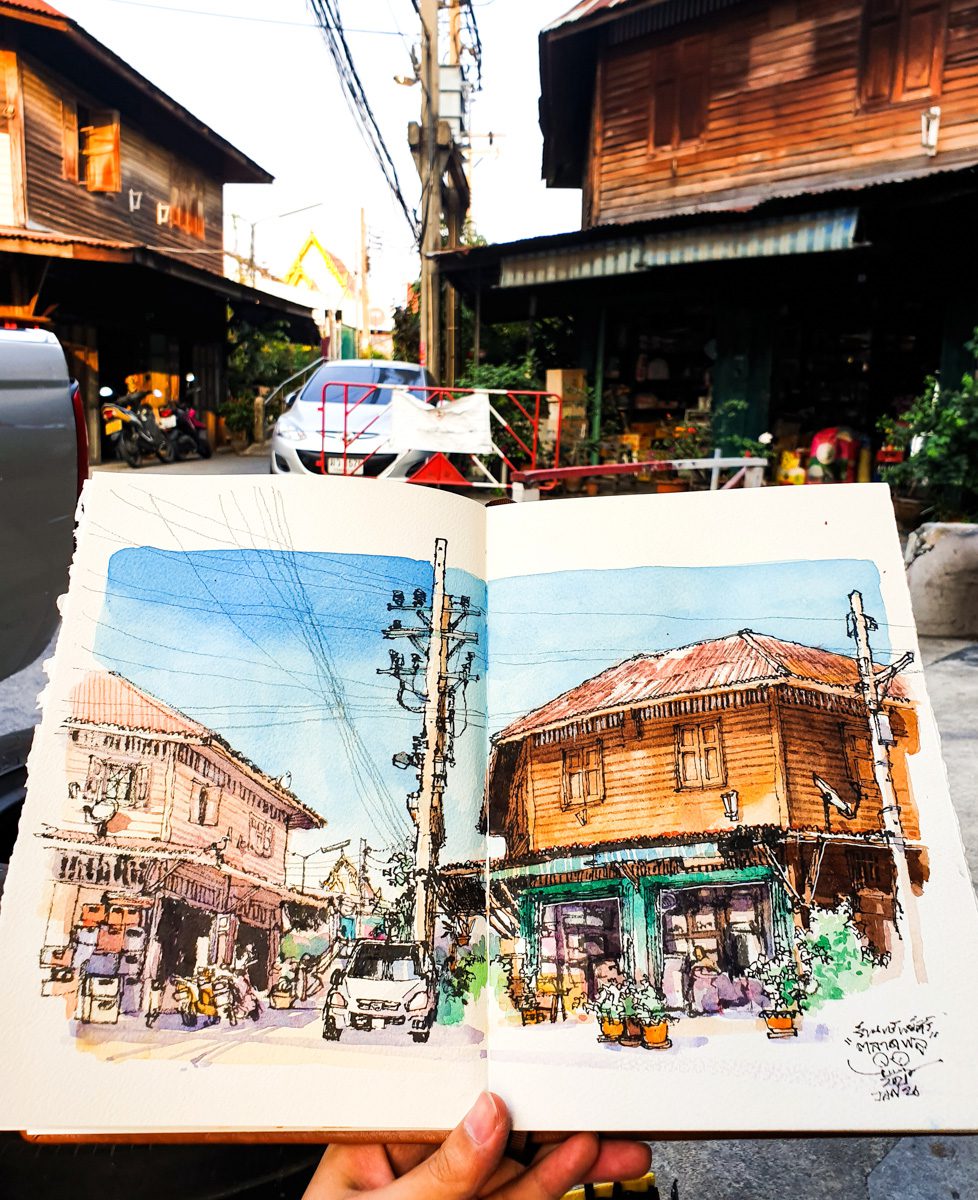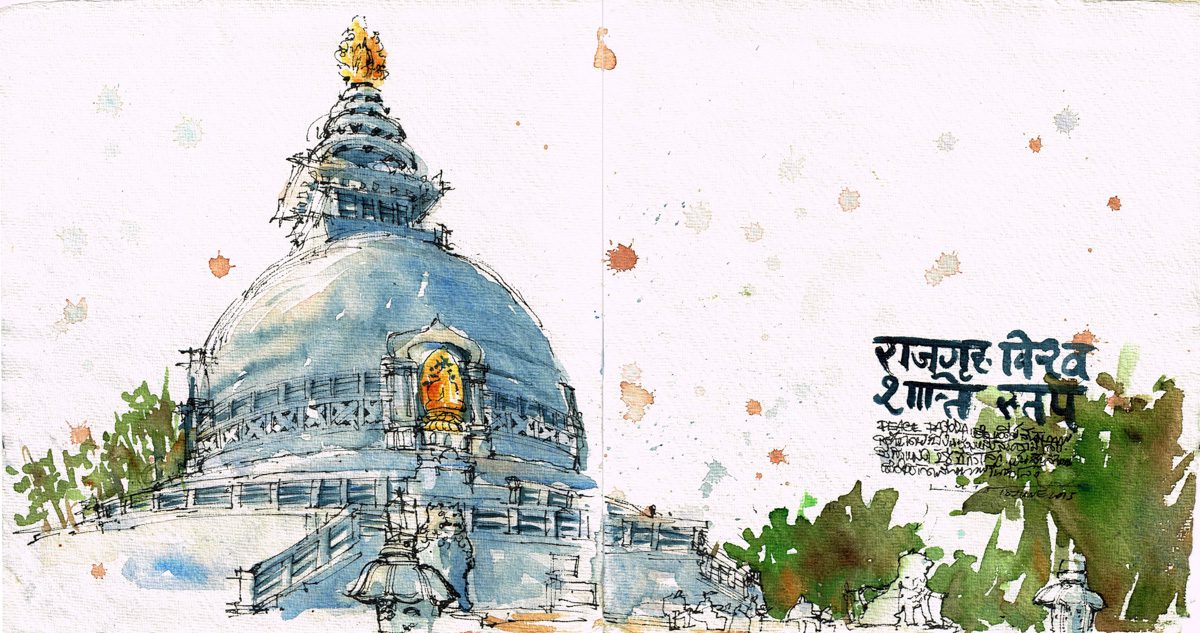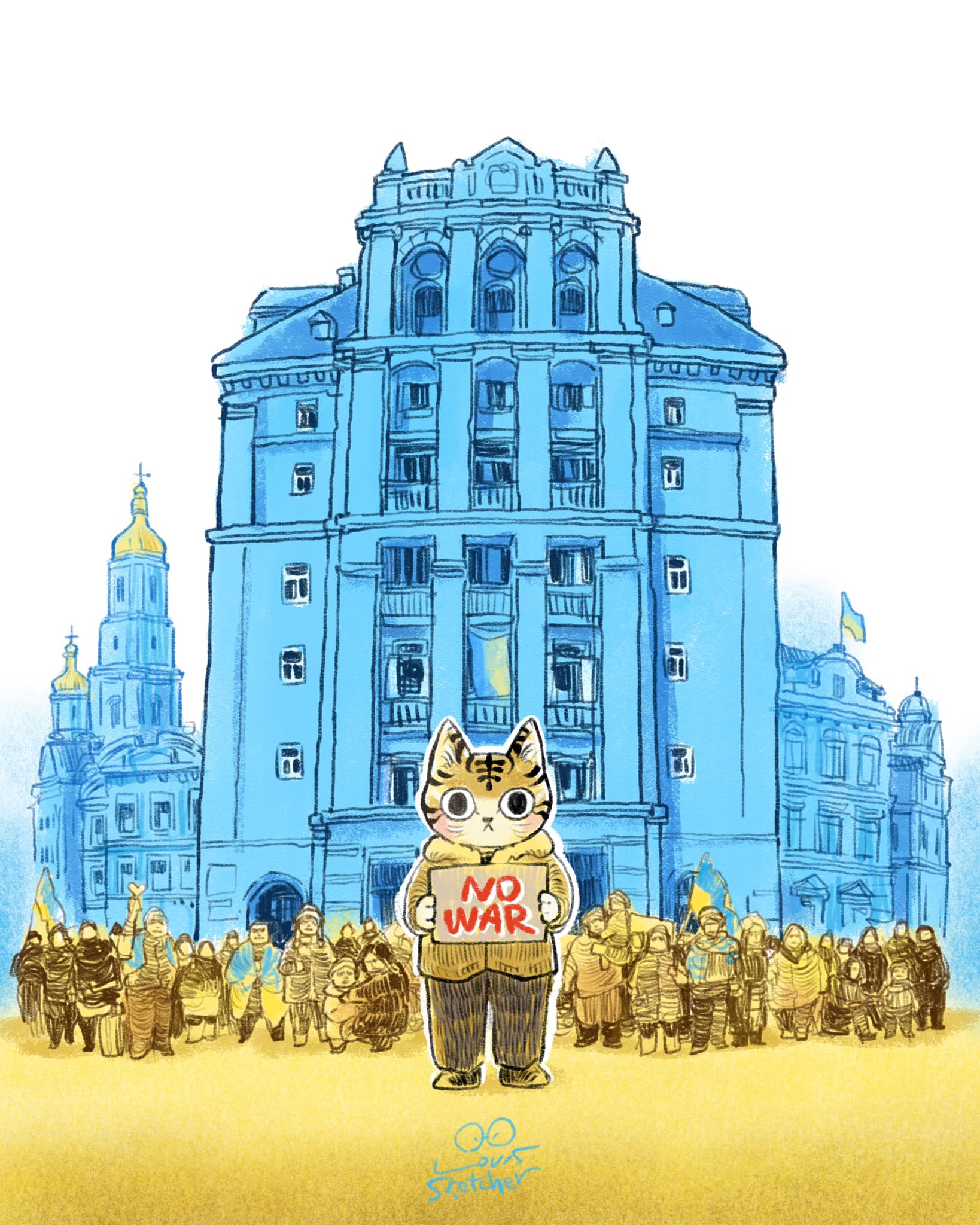art4d TALKS WITH SUPPACHAI ‘LOUIS’ VONGNOPPADONDACHA, THE ILLUSTRATOR AND CREATOR OF THE FAMOUS ‘LOUIS SKETCHER’ PAGE, ABOUT THE PATH OF BEING AN URBAN SKETCHER WHO ARCHIVES THE SENTIMENTS AND EMOTIONS OF CITIES THROUGH HIS VERY OWN PAIR OF EYES AND TWO HANDS
TEXT: KITA THAPANAPHANNITIKUL
PHOTO COURTESY OF LOUIS SKETCHER
(For Thai, press here)
Cities, cats, and hands are probably the three words that best encapsulate Louis Sketcher’s body of work. The lines and details of his sketches; the water-colored, two-legged cat with big, beautiful eyes, which has now become the mascot of his social media page, tell stories of places that are beyond the physical presence of buildings. art4d talks with Suppachai ‘Louis’ Vongnoppadondacha, the illustrator and creator of the famous ‘Louis Sketcher’ page, who switched from his role as a prospective city builder as an architecture student to an archivist of the sentiments and emotions of cities through his very own pair of eyes and two hands.
art4d: When did you start to learn how to draw?
Louis Sketcher: If we are going to count the time when I drew for fun, it started when I was a young student. Afterwards, I attended a drawing class to prepare for my architecture school admission exam, but that class only taught students how to do well at the entrance examination. When I was studying architecture, the most of what I studied was aimed at creating working drawings. I sketched here and there, but nothing significant. During my senior year of college, I began drawing on a regular basis. I met a group of sketchers about this time and began creating more sketches with them. Then I became addicted to it. I would take my notebook to all of these different places more than ever before. When my advisor noticed how much I enjoy drawing and sketching, he invited me to this lecture, where he invited the founder of Bangkok Sketcher to give a discussion at the faculty. I thought the sketchbooks he showed at the talk were cool, so I decided to make my own. That’s when I decided to get a sketchbook and start sketching and drawing seriously.
art4d: So you were interested in drawing before you began studying architecture?
LS: That’s correct. I guess I’ve always enjoyed drawing, but I didn’t get to do it very much. I knew I was good at it, but I wasn’t as invested in it as I am today.

art4d: What made you decide to study architecture?
LS: It was a widespread myth at the time that if you liked to draw and were a science major in high school, architecture was the only option. To be honest, I did not do much digging into other fields. There were tutoring classes for every department in the faculty of decorative arts at Silpakorn University when I was tutoring, but I thought they were far too difficult; in my head I said, there’s no way I’m doing that (laugh). Architecture was the easiest to draw because you didn’t have to create anything realistic. We merely learned to draw rough shapes of people and trees to get the gist of it. Because you didn’t have to be extremely technical, I did quite well back then. I think every student who got into an architecture school knew that we wouldn’t be using these skills for our studies, but as a byproduct of majoring in Thai architecture, I improved a lot with the way I use my hands because I needed to learn how to draw and sketch things that are very difficult and detailed, so I sort of became more familiar and in sync with the way I used my hands, as well as my eyes. I’ve improved my ability to catch all of the different aspects of a building.
art4d: What led to the creation of the Louis Sketcher page? What was the turning point that caused more people to notice your work?
LS: While I was in my fifth year of college, I launched the Facebook page. That wasn’t exactly a smash hit at the time, but it just went on. I believe it was through Instagram that more people became acquainted with me. The algorithm was not as tough as it is now. So I kept publishing my works and using hashtags in the captions, and as a result, people liked them more and my followers increased. I used to be so much simpler (laugh). When large Instagram accounts began to share my work, more people began to follow, mostly foreigners.
art4d: What is the central theme of your sketches?
LS: There isn’t a specific theme, but they are mostly urban sketches. But drawing that alone would be too dry, so I add people, dogs, cats, and other elements into it, and then it moves on to food and so on. This broadens the scope of the art from urban sketches and built structures to stories about neighborhoods. One of my earliest commissions was for a hotel in the Tha Tien district, where they asked me to make postcards to sell at the hotel.

art4d: Has your style changed compared to when you first started?
LS: Significantly. It’s perfectly normal. It’s like how your handwriting changes. I used to do things quickly, and what I drew would look literally like sketches. But I’m more detailed now. I take my time and pay attention to every detail. But it depends really. Some people begin by being extremely detailed and gradually become more instinctive and less refined because, you know, when you draw a lot, there is this urge to draw everything. Stories are also important. I’ve become more interested in characters and scenarios. There’s a series, which depicts my interest in Japanese folklore, so it has this influence from the style and aesthetic of Japanese woodblock printmaking that was mixed into the works.
art4d: How do you feel about the changes in your sketches and the way you draw?
LS: I don’t have any particular feeling about it. These things change over time, and they’re going to continue to change. It also has something to do with the tools I use as well. I used to draw with rOtring pens, but now I use brushes, fountain pens, and an iPad as well.
art4d: What do you think are the charms of urban sketches?
LS: There are significant differences between drawing something from a photograph and being physically present in front of what you’re drawing. To me, it feels like a completely different world. A photograph has its own frame. But to draw a real, physical space, and put it inside a piece of paper, there’s this process of designing and perceiving, getting familiar with the perspective. Take cars for example: you have to find a way to draw the wheels without making them look like they’re floating. Another thing is that when you’re actually there, there will always be something that gets in your way, so you have to work your way around them and know what you should draw, because you don’t have to draw the entire thing. It’s way more fun than drawing from a photograph, at least to me.

art4d: Were there any strange occurrences when you went to places to draw?
LS: There was this one time when I was at Shanti Stupa in India. I needed to climb this peak to the location, which was this beautiful white structure. So I was drawing, and you know how Indians are: they are always eager to learn and have a sense of curiosity. I think their concept of personal space differs from other people’s because we could sit with this much space between us and it would be perfectly normal, but in India, there would be ten strangers standing around you, which was kind of cool.

art4d: We saw you draw the Ukrainian cat for a while; do you usually do work with social implications? What do you think about the relationship or commonality between art illustration and social issues?
LS: In comparison to other artists, I don’t do as many works with social implications. However, I believe that urban art and politics have been closely intertwined. Art is a tool people use to express their feelings, emotions, thoughts, and struggles. It’s simply that we’re seeing more of them lately as a result of the proliferation of artists and art collectives, the introduction and rise of digital art, the emergence of platforms, and people’s willingness and ability to convey their thoughts without relying on verbal or written language. They may have all of these feelings, but they are unable to express them in words, so they can simply share an image that captures what they want to say. The trend has always been there.

art4d: What’s the story behind the Bangkok Shophouse book?
LS: Putting together the shopfronts of all these different stores and establishments in Bangkok is something I’ve wanted to tackle for a long time. They appeal to me because I spent my secondary and high school years in the city’s old quarter. When I started to do more sketches, I had this idea that these storefronts should be put into a collection. But no one was doing it, so I figured, why not do it myself? There’s an index with information about each store’s name and what it sells, as well as a brief architectural history of each structure—just a short overview of architectural styles and the time period in which each work was created.

art4d: Which neighborhoods did you include in the book?
LS: I consider the old town neighborhood and Phra Nakhon district to be the old town district, as well as the area around the Choa Phraya River and the Phadung Krung Kasem Canal. Nevertheless, I did not focus on historical accuracy in general, only on the approximate vicinity of what I consider to be the old town quarter (laugh). There is also Thonburi and Talat Phlu on the other side of the river. I didn’t want the buildings to appear too dry, so I added people, food vendors, and other similar elements.
art4d: In a way, you are documenting the urban history of cities.
LS: These urban sketches can be considered a form of documentation in their own right. It’s a diary of sorts. Consider, for example, the sketches I created of communities like Talat Phlu; there’s a good probability that these areas may change or disappear. I drew sketches of Wang Lang, and the area has since been replaced by tall building structures. Similarly, the gold shop I drew in Yaowarat, Chinatown, now has a new façade, and some of the wonderful signage I adored has vanished. In a way, yes, I have been documenting parts of history because the city keeps changing. There are some of the drawings I finished, and now some of the things in them have gone. There are places that I revisited, like the MBK Center or Wat Pho, where the buildings and the places have changed a bit. And even if I were at the same spots, but at different times, they won’t be the same, and the places would have changed in their own ways. Another advantage is that drawing allows me to recall being emotionally immersed in a place because it takes time for me to complete a piece, so I was able to really absorb everything. I may not have to like the experience, but I remember it. I might have had a bad memory when I was doing a sketch, like when a dog was walking around and blocking the scene, or when I was drawing on a late evening and all these flying termites started to swarm the place. These things become memories of all these different places, and they make me remember and become emotionally attached to the city, whether those memories are good or bad.

art4d: Who are your favorite artists?
LS: There are so many of them. There’s Zao Dao, a Taiwanese artist. I think they’re really good, like, too good (laugh). Their drawings have a certain cuteness about them. It’s cool, and the characters’ placement is excellent. Another artist that I like is Little Thunder whose work is more character-oriented. I like how they draw female characters with such a delicate touch. But my ultimate idol has to be Kim Jung Gi. He doesn’t sketch the outlines and can just draw things, like a continuous flow. I used to listen to one of his live broadcasts where he talked about drawing 14-15 hours a day when he was younger (laugh). The most talented sketcher, in my opinion, is the one who has a lot of information. King Jung Gi not only draws people, but also animals, movements, gestures, and muscles, as well as objects such as equipment, weapons, and military tanks. So it’s not just about having the information, but also about having a hand that moves in sync with your mind.
art4d: In which direction do you think the future of Louis Sketcher will head? Any ideas cooking up or plans in mind?
LS: I want to make more books. Each book that I create, I work on the sketches and the writing, as well as the research. It can be exhausting, but I like it. Maybe I can create new characters, add more stories to the sketches, and put them together into an art book, like the ones done by other artists, so I don’t have to burden myself with all the writing.
art4d: Have you ever considered honing your skills to the level of Kim Jun Gi?
LS: I understand that it must have taken time and an incredible amount of effort to be at that level, and I don’t think I have that in me (laugh). Sure, that is one of my ultimate goals, but I’m not that hard on myself if I won’t be able to get there. I think each artist has their own origin and journey that make their sketches different and unique.








